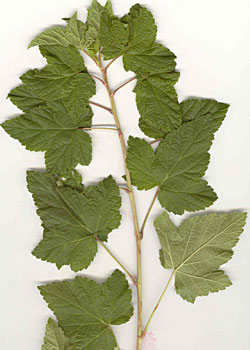Relatives
Ribes pauciflorum Turcz. ex Pojark. - Oliganthous currant.
Taxonomic position.
Family Grossulariaceae Hill; genus Ribes L.Morphology and biology.
Perennial shrub up to 1.5 m tall with yellowish grey, downy shoots and numerous soboles. Leaves are 5-8 cm wide, bare above and downy along the veins on the underside, usually five-lobed with short, gently obtuse lobes of wide-triangular shape; the middle lobe is generally larger than the lateral ones. Petioles are 4.5-5 cm long. Racemes are short, 1.5-3 cm in length, with 3-6 (8) flowers. Pedicels are 1.5-3 mm long, densely covered, as is the rachis, by simple white hairs interspersed with single glandules. Flowers are yellowish, small, 6-7 mm long, densely downy on the outside. Hypanthium is short, hemispheric, smooth; its width is twice the length. Yellowish brown calyx lobes are straight or slightly deflected, lanceolate, up to 4.5 mm in length and 2 mm wide, covered by long white hairs and sparsely dotted by glandules on the outside. Petals are ellipsoidal, 2 mm long and 1.2 mm wide, bare, yellowish. Styles are conical, whole, coalesced almost to the stigmata. Ovary is semi-inferior, lofty conical, densely glandular at the bottom. Berries are large, 10-13 mm in diameter, set on thick stems, black, edible, fragrant and sweet. Blossoms in May/June; bears fruit in July/August. Entomophilous. Zoochore.Distribution.
Occurs throughout Mongolia, Japan and China. Within the former USSR, the species occurs in Eastern Siberia and the Far East.Ecology.
Grows in mixed and deciduous forests (both mountainous and flood-plain ones), in river valleys, on stony mountainsides and in clearings. Plants are single or grouped in thickets. Often inhabits dry fire sites, where it grows rather copiously.Utilization and economic value.
Distinguished for its exceptional flavor. Widely used by local populations to make jams, fruit liqueurs and other products. Sometimes is grown (cultivated) by residents in household orchards. Deserves wider domestication and involvement in breeding practice.References:
Harkevich S.S., ed. 1988. Vascular plants of the Soviet Far East. Vol. 3. Leningrad: Nauka, p. 126. (in Russian).Komarov V.L., ed. 1939. Flora of the USSR. Vol. IX. Moscow-Leningrad: Publishing House Acad. Sci. USSR, p. 250-251. (in Russian).
Malyshev L.I., Peshkova G.A., eds. 1979. Flora of the Central Siberia. Vol. I. Onocleaceae-Saxifragaceae. Novosibirsk: Nauka, p. 432. (in Russian).


